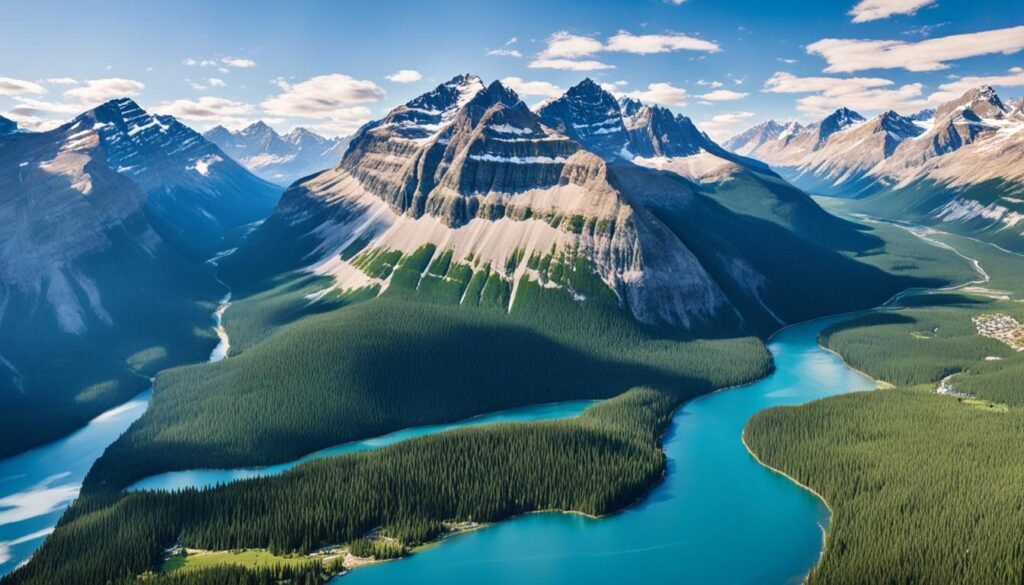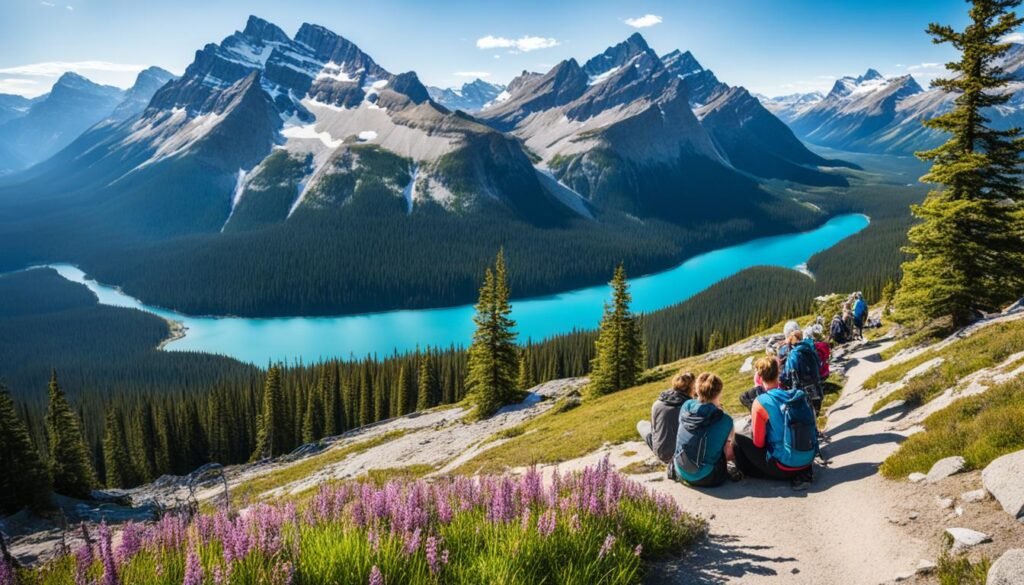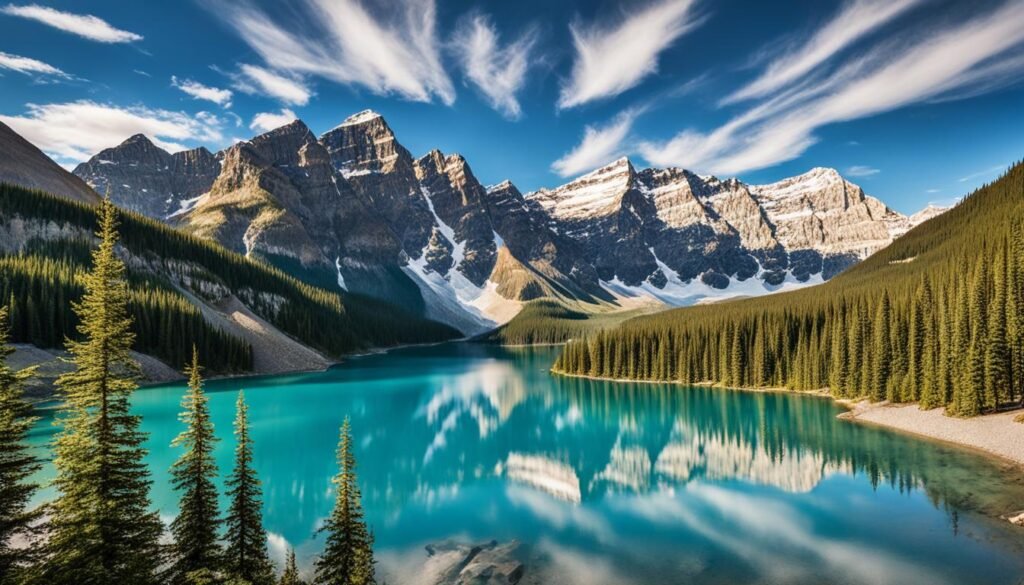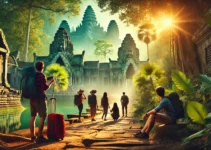I’m excited to guide you through the Canadian Rocky Mountains. This guide will show you the best hiking trails, scenic spots, and adventure areas in North America’s stunning national parks.
The Canadian Rockies are known for their stunning landscapes. From snow-covered peaks to clear lakes, they are breathtaking. In 2021, Jasper National Park welcomed 2.1 million visitors, showing its popularity despite the pandemic.
A highlight is the Jasper SkyTram, Canada’s longest and highest tram. It takes you up 7,424 feet for views that are simply amazing. For a relaxing time, visit Miette Hot Springs. Here, the water goes from 129°F to 104°F in pools rich in minerals.
At night, the Rockies are magical. Jasper National Park is a Dark Sky Preserve, perfect for stargazing. It’s a chance to see the stars up close without any light pollution.
Key Takeaways
- The Canadian Rockies offer diverse landscapes and outdoor activities
- Jasper National Park is a must-visit destination with unique attractions
- The region provides opportunities for both adventure and relaxation
- Stargazing in Jasper’s Dark Sky Preserve is a unique experience
- This guide covers multiple national parks and cultural experiences
- The travel guide is priced at $19.99 and includes over 35 maps
Introduction to the Canadian Rockies
Join me on an exciting journey through the stunning Canadian Rockies. This range stretches across Alberta and British Columbia, making it perfect for those who love the outdoors. It’s filled with towering peaks and pristine lakes, making it a natural wonder.
Geography and Landscape
The Canadian Rockies cover two provinces, offering breathtaking views. The highest peak, Mount Robson, stands tall at 12,972 feet. You’ll see glaciers, turquoise lakes, and dense forests along the way.
The Icefields Parkway, a 232-kilometer scenic drive from Jasper to Banff, is a must-see. It’s a beautiful route through the mountains.
Climate and Seasons
The climate in the Canadian Rockies changes with the seasons. Summer, from June to August, is the best time to visit, with temperatures between 15°C and 25°C. Fall brings cooler weather and fewer people.
Winter turns the region into a snowy paradise, ideal for mountaineering and winter sports. Spring is mild and less crowded, making it perfect for enjoying the outdoors.
Wildlife and Ecosystems
The Canadian Rockies are full of diverse ecosystems and wildlife. You might see elk, moose, and even grizzly bears. Jasper National Park is a great spot for stargazing, thanks to its Dark Sky Preserve status.
The region’s five national parks—Banff, Jasper, Yoho, Kootenay, and Waterton Lakes—each offer unique landscapes and activities. They are perfect for nature lovers.
| National Park | Key Features | Popular Activities |
|---|---|---|
| Banff | Turquoise lakes and glaciers | Hiking, canoeing, and hot springs |
| Jasper | Stunning vistas, abundant wildlife | White-water rafting, boat cruises |
| Yoho | Dramatic peaks, fossil beds | Hiking, fossil viewing |
| Kootenay | Serene hot springs, beautiful trails | Hot spring soaking, hiking |
| Waterton Lakes | Towering mountains, crystal-clear lakes | Hiking, wildlife watching |
Best Time to Visit the Canadian Rockies
I love visiting the Canadian Rockies, and timing is key for an unforgettable experience. The peak season runs from June to September, offering warm weather and a wealth of outdoor activities. During this time, hiking trails come alive, and scenic viewpoints are at their most accessible.

For camping enthusiasts, mid-May to mid-September is ideal. Campsites are open, and the weather is perfect for outdoor adventures. Lakes typically defrost by mid-June, making water activities like kayaking on Lake Moraine a possibility. Wildlife spotting opportunities are abundant during these months, with animals emerging from their winter habitats.
“The Canadian Rockies offer trails that are mostly moderate to challenging, with altitudes up to 2,500m and some steep ascents.”
If you’re after fall colors, plan your visit for mid-September. The landscape transforms into a breathtaking palette of autumnal hues, perfect for photography enthusiasts. Just remember to pack layered clothing, as temperatures can vary widely, ranging from -17°C to 69°C throughout the year in places like Jasper.
| Season | Average Temperature | Activities |
|---|---|---|
| Summer (Jun-Aug) | 37°F to 76°F | Hiking, rafting, canoeing, and camping |
| Fall (Sep-Oct) | 35°F to 60°F | Wildlife viewing, autumn colors |
| Winter (Nov-Apr) | Below 0°F to low 30s | Snow sports, winter landscapes |
| Spring (May) | 35°F to 65°F | Early hiking, fewer crowds |
While planning your trip, consider exploring other iconic destinations to complement your Canadian Rockies adventure. Remember, the best time to visit depends on your preferences and the activities you want to experience in this stunning natural paradise.
Planning Your Trip: A Traveler’s Guide to the Canadian Rockies
I’m excited to share tips on planning a trip to the Canadian Rocky Mountains. This area is perfect for adventure lovers and those who love nature. Let’s look at what you need to know to make your trip great.
How Many Days to Allocate
For a full experience, plan to spend at least 10 days in the Canadian Rockies. This lets you see places like Banff and Jasper National Parks. If you can, stay for three weeks to explore more of the area’s beauty.
Transportation Options
Driving is the best way to see the Canadian Rockies. It lets you stop at beautiful spots and go on remote trails. If flying in, start in Calgary for your Canadian Rockies road trip. Or, take a train for amazing views without driving.
Accommodation Choices
The Canadian Rockies have places for everyone. Luxury lovers can stay at top resorts like the Fairmont Banff Springs Hotel. Those on a budget might like rustic cabins or campgrounds in national parks. Always book early, especially in summer when Banff gets very busy.

Tip: Visit in the shoulder seasons (May and October) for better prices and fewer people. Winter is magical, with skiing and ice skating for those who love adventure.
| Season | Pros | Cons |
|---|---|---|
| Summer (Jun-Sep) | Warm weather, hiking trails open | Crowded, expensive |
| Winter (Dec-Mar) | Winter sports, fewer crowds | Cold temperatures, some attractions closed |
| Shoulder (May, Oct) | Lower prices, mild weather | Some facilities may be closed |
With good planning, you’re all set for an amazing trip through the Canadian Rockies. Don’t forget warm clothes, and get ready for an adventure you’ll always remember!
Must-Visit National Parks
The Canadian Rockies are home to some of the most stunning national parks. Each park has its own unique landscapes, trails, and viewpoints. Let me guide you through these natural wonders.
Banff National Park
Banff National Park is a true treasure. It’s famous for Lake Louise and Moraine Lake, with their stunning mountain views. Try to get there early in July and August to avoid the crowds.
The Johnston Canyon hike is a must. It features unique walkways right by the canyon.

Jasper National Park
Jasper National Park offers a wild adventure. The Jasper SkyTram gives you amazing views, and Maligne Lake is beautiful with Spirit Island. Don’t miss the Valley of the Five Lakes trail for five turquoise lakes.
Yoho National Park
Yoho National Park is a hidden gem. Emerald Lake is as green as its name suggests. It’s less crowded in the morning.
Takakkaw Falls is another must-see. It’s powerful and easy to get to.
Kootenay National Park
Kootenay National Park is great for a peaceful visit. It has mountains and lakes like the big parks but is less crowded. The Marble Canyon trail is a favorite, showing off the park’s unique geology.
Book your stay and rentals early, especially in summer. Always carry bear spray and hike with others when advised. These parks are perfect for nature lovers, offering beauty and hiking trails.
Iconic Landmarks and Natural Wonders
I’m excited to share my top scenic spots in the Canadian Rocky Mountains. These stunning landscapes attract millions each year. They offer breathtaking views, from pristine lakes to towering peaks.
First up is Lake Louise, a gem with turquoise waters under Victoria Glacier. Nearby, Moraine Lake’s blue waters reflect the mountains beautifully. Both lakes are perfect for photos and hiking.

The Columbia Icefield is another wonder. It sits between Banff and Jasper National Parks, getting lots of snow. The drive from these parks is unforgettable, with glaciers, wildlife, and mountains.
In Jasper National Park, Maligne Lake is a highlight. Spirit Island is a top photo spot. Don’t miss the thundering Athabasca Falls or the views from the Jasper SkyTram.
| Landmark | Location | Notable Feature |
|---|---|---|
| Lake Louise | Banff National Park | Turquoise waters, Victoria Glacier backdrop |
| Columbia Icefield | Banff/Jasper National Parks | 7 meters annual snowfall |
| Maligne Lake | Jasper National Park | Spirit Island, iconic photo spot |
| Athabasca Falls | Jasper National Park | Powerful waterfall |
For something different, visit the hoodoos near Banff. These unique rock formations show nature’s creativity. Mistaya Canyon and Peyto Lake are also must-sees. The Rockies’ beauty draws nature fans from all over the world.
Outdoor Activities and Adventures
The Canadian Rockies are a dream for those who love adventure and nature. They offer a wide range of outdoor activities. Whether you’re into hiking or spotting wildlife, there’s something for you.
Hiking and Trekking
Hiking in the Canadian Rockies is an experience you won’t forget. I’ve explored trails ranging from easy walks to tough treks. The Sentinel Pass Hike in Banff National Park is a must-try, with a 2,600-climb over 7 miles.
For a bigger challenge, try the Iceline Trail in Yoho National Park. It has a 3,000-climb over 10 miles.
Wildlife Viewing
Seeing wildlife in the Rockies is a big part of the fun. In Jasper National Park, I’ve seen elk, moose, mountain goats, and black bears. For a safe and fun way to see wildlife, consider joining a guided tour.
Water Activities
The lakes and rivers in the Rockies are perfect for water fun. I enjoy canoeing on Lake Louise and rafting on the Athabasca River. These activities let you see the stunning views from a different angle.
Winter Sports
Winter turns the Rockies into a snowy paradise. Skiing, snowshoeing, and ice skating on frozen lakes are popular. For a breathtaking view any time of year, take a ride on the Jasper SkyTram.
When planning your outdoor adventures, remember to avoid tourist traps and go for real experiences. The best time for hiking and exploring is from mid-June to mid-September. But the season is short, so plan early!
| Activity | Location | Difficulty | Duration |
|---|---|---|---|
| Sentinel Pass Hike | Banff National Park | Moderate/Advanced | 6 hours |
| Iceline Trail | Yoho National Park | Advanced | 6-8 hours |
| Athabasca Glacier Ice Walk | Jasper National Park | Moderate | 3 hours |
| Maligne Canyon Hike | Jasper National Park | Easy | 2 hours |
Scenic Drives and Road Trip Routes
I love exploring the Canadian Rocky Mountains by car. The Icefields Parkway is a must-drive route. It connects Banff and Jasper National Parks over 230 km, offering stunning views of glaciers, peaks, and wildlife. Plan to spend at least two full days to enjoy this journey fully.
The Bow Valley Parkway is great for a slower pace. It’s an alternative to the Trans-Canada Highway, with many scenic spots and animal sightings. Make sure to fill up your tank before leaving, as gas stations are few.
For a quieter experience, consider a loop that includes Waterton Lakes National Park and towns like Fernie and Golden. These places offer a closer Rocky Mountain experience.
The best time to visit is from mid-June to early September. You’ll get ideal weather and clear views of the beautiful lakes. For fewer tourists and lower prices, go in late May or early October.
- Calgary to Banff: 1.5 hours
- Edmonton to Jasper: 3 hours
- Banff to Jasper via Icefields Parkway: 3–4 hours (without stops)
The journey through the Canadian Rockies is as amazing as the places you’ll visit. Take your time, stop often, and enjoy the incredible views.
Local Cuisine and Dining Experiences
The Canadian Rockies offer a feast for the senses, blending breathtaking views with mouthwatering cuisine. I’ve discovered that adventure tourism in this region extends beyond outdoor activities to include culinary explorations.
Traditional Canadian Dishes
My taste buds were tantalized by local specialties like bison burgers and Alberta beef. These dishes showcase the region’s rich culinary heritage. It’s a mix of First Nations traditions and European influences.
The Station Restaurant in Jasper serves up unpretentious fare in a historic railway station. It’s perfect for a post-hike meal.
Top Restaurants and Eateries
The Canadian Rockies boast an impressive array of dining options. In Banff, I enjoyed the Vermillion Room at the Fairmont Banff Springs Hotel. It’s known for its French cuisine and mountain views.
For breakfast, Juniper Bistro offered delightful fare alongside stunning vistas. In Jasper, I savored international flavors at the Raven Bistro. Tekarra Restaurant served classic Canadian dishes like braised bison short ribs.
For a unique experience, I dined at Sky Bistro in Banff. It offers expansive mountain views from an elevation of 7,486 feet.
Food Tours and Culinary Experiences
To fully immerse myself in the local food scene, I joined culinary tours. These tours showcased regional ingredients and cooking traditions. They not only satisfied my palate but also deepened my appreciation for the Canadian Rockies’ gastronomic landscape.
| Restaurant | Location | Specialty | Price Range |
|---|---|---|---|
| Wild Flour Banff’s Artisan Bakery Café | Banff | Breakfast and Lunch | Budget |
| Bear Street Tavern | Banff | Smoked Bison Pizza | Moderate |
| Juniper Bistro | Banff | Local Ingredients and Gluten-Free Menu | Upscale |
| Storm Mountain Lodge | Banff National Park | Fine Canadian Cuisine | Upscale |
My culinary journey through the Canadian Rockies was as diverse and exciting as the adventure tourism opportunities in the region. From rustic lodges to fine dining establishments, each meal added a new dimension to my Rocky Mountain experience.
Cultural Experiences and Indigenous Tourism
There’s more to exploring the Canadian Rockies than just being outside. This is a thorough exploration of the diverse cultures of Indigenous peoples. More than 204 Indigenous groups in British Columbia speak more than thirty languages. Travelers can connect with historic customs and wisdom through this.
Indigenous people have lived in this area for 10,000 to 20,000 years. Currently, 1.8 million Indigenous people, or 5% of the total population, reside in Canada. The Canadian Rockies are heavily influenced by their legends and customs.
The Mahikan Trails guided walk was a delight. They shared their Indigenous perspectives on the land and told me about traditional herbs. Seeing the Rockies through their eyes was breathtaking.
I also went to some local cultural institutions and museums. These locations showcase Indigenous history and art. They provide a thorough analysis of the significance of the land to Indigenous peoples. It’s a powerful means of promoting reconciliation and the truth.
If you want to go deeper, consider renting a campsite from an Indigenous person or joining an Indigenous person-led excursion. These provide unique avenues for fostering ties with the region’s indigenous population. You also get to take in the breathtaking splendor of the Canadian Rockies.
“Exploring Indigenous tourism in the Canadian Rockies isn’t just about sightseeing. It’s about understanding, respecting, and preserving ancient cultures that are still very much alive today.”
Packing Essentials for the Canadian Rockies
Packing for the Canadian Rockies means planning carefully. You need to get ready for different weather and activities. Layering is key to staying comfortable in changing temperatures.
For hiking and mountaineering, I always choose sturdy, waterproof boots. They’re vital for rough trails and keeping feet safe from the weather. I also bring merino wool socks to keep my feet dry and comfy on long hikes.
I prefer lightweight, moisture-wicking shirts and pants for outdoor activities. They help keep my body’s temperature steady. A puffy coat is also a must-have for cold nights and packs small in my backpack.
For camping, a good-quality sleeping bag and a compact tent are essential. I also carry a reliable headlamp for navigating at night and a first-aid kit for emergencies.
| Item | Purpose | Recommendation |
|---|---|---|
| Hiking Boots | Trail Safety | Merrell Waterproof |
| Backpack | Gear Storage | Timbuk2 Launch Pack |
| Jacket | Weather Protection | Patagonia Puffy Coat |
| Socks | Comfort | Merino Wool |
Remember to pack bear spray if you’re heading into bear country. And don’t forget a good camera to capture the stunning views of the Canadian Rockies!
Conclusion
I have described my trip through the Rocky Mountains of Canada. I hope it encourages you to go out on a new journey. These parks are unforgettable, from the serene beauty of Jasper to the breathtaking views of Banff National Park.
For eight days, our six-person group traveled across the area. We traveled the Icefields Parkway for 4.5 hours. Maligne Canyon Loop Trail is 2.3 miles long; we trekked it and made five stops for sightseeing.
A 1.5-hour hike led to the Valley of the Five Lakes. It showcased the stunning scenery of the region.
There is something for everyone in the Canadian Rockies, whether you are planning a quick trip or a 13-day journey. Every year, more than 3 million individuals travel to Banff. For many, it’s the best option.
Remember to reserve your Lake Louise shuttle in advance. At 5,200 feet, Lake Louise Village is the highest settlement in Canada.
Consider all the things you can do when you are organizing your trip. From short strolls to strenuous treks like the Castle Mountain Lookout Trail,. Adventure seekers and nature enthusiasts will adore the Canadian Rockies.
FAQ
What is the best time to visit the Canadian Rockies?
The best time to visit is from June to September for warm weather and easy hiking. But it’s also the busiest and most expensive time. Late September is great for seeing fall colors with fewer people around.
May and early June are good for avoiding crowds, but some trails might still be snowy. Winter (November to April) is special with snow scenes and winter sports. But some places might be closed.
How many days should I allocate for exploring the Canadian Rockies?
Plan for at least 10 days to three weeks to fully experience the Canadian Rockies. Driving yourself is best for seeing everything you want. It lets you stop whenever you find a beautiful view.
What are the must-visit national parks in the Canadian Rockies?
Don’t miss Banff National Park for its famous Lake Louise and Moraine Lake. Jasper National Park has the Jasper SkyTram, Maligne Lake, and lots of wildlife. Yoho National Park is home to Emerald Lake and Takakkaw Falls.
Kootenay National Park is quieter but has beautiful mountains and lakes too.
What are some iconic landmarks and natural wonders in the Canadian Rockies?
Must-sees include Lake Louise, Moraine Lake, and the Columbia Icefield in Banff. Jasper National Park has Maligne Lake, Spirit Island, and Athabasca Falls. Don’t forget the Jasper SkyTram.
Natural wonders include the hoodoos near Banff, Mistaya Canyon, and Peyto Lake’s turquoise waters.
What outdoor activities and adventures can I experience in the Canadian Rockies?
There are easy walks and tough hikes to try. You can see wildlife on guided tours. Activities include canoeing on Lake Louise and white-water rafting on the Athabasca River.
In winter, enjoy skiing, snowshoeing, and ice skating on frozen lakes.
What are some scenic drives and road trip routes in the Canadian Rockies?
The Icefields Parkway (Highway 93) is a stunning 232 km drive from Banff to Jasper. It shows off glaciers, mountains, and wildlife. The Bow Valley Parkway is a slower drive with chances to see wildlife.
For a unique trip, consider a loop through Waterton Lakes National Park and towns like Fernie and Golden. It’s less crowded.
What culinary experiences should I explore in the Canadian Rockies?
Try local foods like bison burgers and Alberta beef. The Station Restaurant in Jasper has simple but tasty food in a historic spot. The Fairmont Jasper Park Lodge has many places to eat, including The Nook Smokehouse for smoked brisket.
In Banff, there are many places to eat. Look for food tours or experiences that highlight local foods and traditions.
How can I engage in cultural experiences and Indigenous tourism in the Canadian Rockies?
Learn about the area’s culture through Indigenous tourism. Mahikan Trails offers walks that teach about traditional plants and Indigenous views. Visit pow-wows or check out museums and cultural centers for more insight.
These activities help you understand the land’s importance to Indigenous peoples and support truth and reconciliation.
What should I pack for visiting the Canadian Rockies?
Bring layers for changing weather, including warm clothes in the summer. Take hiking boots, rain gear, and sun protection. For winter, pack warm boots and clothes.
Remember to wear bear spray when hiking and camping. A good camera is a must for the beautiful views. If you’re hiking or doing winter sports, bring the right gear, like microspikes or avalanche safety equipment.


